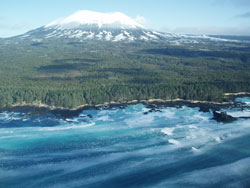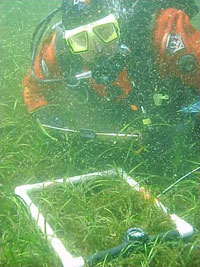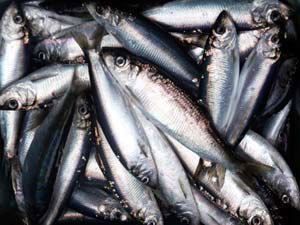Pacific Herring
(Clupea pallasii)
Printer Friendly
Did You Know?
On average, a female Pacific herring lays 20,000 eggs each year.
General Description
Herring have a blue-green upper body with silvery sides and are devoid of markings. The body is laterally compressed and the scales along the underside project in a slightly serrated arrangement. Scales are large and easily removed. Their tails are deeply forked and they lack adipose fins. These fish may grow to 18 inches in length, but a 9-inch specimen is considered large.
Their blue-green upper body, large scales, and large eyes help distinguish them from other silver fish species of similar size.
Life History
Growth and Reproduction
Pacific herring are sexually mature at 3–4 years of age and spawn every year after reaching maturity. Spawning occurs in the spring in shallow, vegetated areas in intertidal and subtidal zones. Males and females release their milt and eggs into the water column where they mix and fertilize. The eggs are adhesive and attach to vegetation or the bottom substrate.
Eggs hatch about two weeks after fertilization and the young larvae drift and swim in the ocean currents. Once the larvae undergo metamorphosis into their juvenile stage, they rear in sheltered bays and inlets. In the fall, the schools of juveniles move to deeper water where they will spend the next 2-3 years. They will remain separate from the adult population until they are mature.
Feeding Ecology
Pacific herring feed seasonally on phytoplankton and zooplankton, building up fat stores for periods of inactivity. They generally feed in surface waters at night in areas of upwelling. Young herring feed mainly on crustaceans but will eat decapods and mollusk larvae. Adults consume mostly large crustaceans and small fish.
Behavior
Pacific herring travel in large schools.
Migration
Pacific herring travel to inshore waters to spawn then migrate back to offshore waters to feed. They exhibit a diel vertical migration pattern, remaining near the bottom during the daylight hours and moving to shallow waters to feed at night.
Range and Habitat
Pacific herring are found throughout coastal waters of the Pacific Ocean. In the western North Pacific, they are found in the western Bering Sea to Kamchatka, in the Okhotsk Sea, and around Hokkaido, Japan southeast to the Yellow Sea. In the eastern North Pacific, they range from Baja California north to the Beaufort Sea. They also occur in the Russian Arctic from the Chukchi Sea to the White Sea.
Pacific herring spawn in inshore waters and feed in offshore waters. They occupy the water column from the surface to depths of 1300 feet.
Status, Trends, and Threats
Status
Herring population abundance trends are very dynamic and are subject to fairly substantial changes on both large and small geographic scales. The primary cause for such fluctuations in abundance is environmental change that affects herring growth and recruitment.
NatureServe: National – N5 (Apparently secure)
ESA: Not warranted
Trends
Overall, Alaska herring stocks are well managed for their long-term sustained yield. In Southeast Alaska, herring abundance is trending upwards since 1980. The Pacific herring population in Prince William Sound collapsed in 1993, 4 years after the Exxon Valdez oil spill. The cause has yet to be determined and the population has shown little sign of recovery.
Threats
A threat to Pacific herring is the loss of spawning grounds. This habitat has been degraded or destroyed by dredging, construction activities, log storage, oil spills, and decreases in water quality. Global warming may also pose a threat to the species by reducing the availability of their prey; zooplankton and phytoplankton. In addition, the recovery of populations of predator species, such as humpback whales, may impact herring populations.
Fast Facts
-
Size
Can grow up to 18 inches -
Lifespan
8–16 years -
Range/Distribution
Coastal waters throughout the Pacific Ocean -
Diet
Zooplankton and phytoplankton -
Predators
Other fish, marine mammals, and birds -
Reproduction
Mass spawners with external fertilization
Did You Know?
- The time it takes for Pacific herring eggs to hatch is dependent on the water temperature.
- On average, a female Pacific herring lays 20,000 eggs each year.
Uses
Subsistence
Subsistence fisheries for herring in Alaska predate recorded history. The spring harvest of herring eggs on hemlock boughs or kelp has always been an important subsistence resource in coastal communities throughout Alaska). Traditional dried herring remains a major staple of the diet in Bering Sea villages near Nelson Island. Pacific herring are also harvested by subsistence users for consumption as fresh fish and for bait.
Commercial
The commercial herring fishery in Alaska began in 1878. The herring were originally used for human consumption, bait, and reduction (the production of fish meal and fish oil). Peak catches for the Pacific herring industry occurred in 1929 with 78,745 tons of fish harvested. The reduction fishery ended by 1967. Currently, herring are harvested from Southeast Alaska to Dutch Harbor for use as bait in halibut, groundfish, crab, and salmon troll fisheries.
The primary commercial use of herring is sac roe for foreign markets. Sac roe is the term used to describe the herring eggs while they are still in the skeins (the membrane that holds the eggs together inside the fish). The sac roe fishery began in Southeast Alaska in 1971 and now occurs from Southeast Alaska up to Norton Sound. Pacific herring for the sac roe industry are harvested by gillnetters and purse seiners.
There is also a commercial harvest for herring eggs on kelp. The most common commercial spawn-on-kelp harvests occur with the use of pounds (floating pens), where herring are captured in purse seines and confined in enclosures containing harvested kelp until they spawn. In some areas the kelp is harvested by divers or handpicked in intertidal areas. The product from these pound harvests typically sells for a very high value.
The majority of the Alaska harvest has been taken in sac roe fisheries. The total Statewide sac roe harvest in 2009 was approximately 40,500 short tons resulting in $17.1 million paid to fishermen for their catches (Commercial Fisheries Division website). The commercial fishery for herring eggs on kelp in Southeast Alaska harvests and average of 300 tons annually (most recent 10-year period) with approximately $2.5 million paid to fishermen for their harvests.
Management

The Alaska Department of Fish and Game (ADF&G) manages food and bait, sac roe, roe on kelp, and herring pound fisheries in state waters through limited entry and open entry programs. For additional information regarding ADF&G management of herring, see the Commercial Herring Fisheries site.
Research

Historically, ADF&G has conducted two direct observational methods for estimating herring biomass in Southeast Alaska: (1) egg deposition dive surveys, and (2) vessel hydroacoustic surveys. In cases where egg deposition surveys are used, the biomass estimate is based on data only from mature herring that spawned that season. Acoustic surveys have not been used to estimate biomass since the 1993/94 season, because the method is thought to be less reliable than egg deposition estimation.
Herring stock assessment activities begin in the spring with aerial and foot surveys conducted by department staff. Herring spawning activity is documented during these surveys and used to determine, among other things, where to distribute SCUBA dive transects. The dive transects are used to derive egg deposition estimates which are used along with many other biological parameters, including age and growth, to estimate spawning biomass. Age and growth information are obtained by samples collected from test fishing, commercial harvests, mid-water trawling, and sampling on the spawning grounds by the department.
Forecasts for herring in Southeast Alaska are currently computed using either an Age-Structured Analysis (ASA) or a biomass accounting method where the observed spawning biomass and age composition from one year is modified by estimates of growth and mortality to produce a forecast for the subsequent year’s biomass.
More Resources
- Pacific Herring — Wildlife Notebook Series (PDF 43 kB)
- National Marine Fisheries Service (NMFS) Office of Protected Resources
- NMFS Alaska Regional Office
- Exxon Valdez Oil Spill Trustee Council (EVOSTC)


